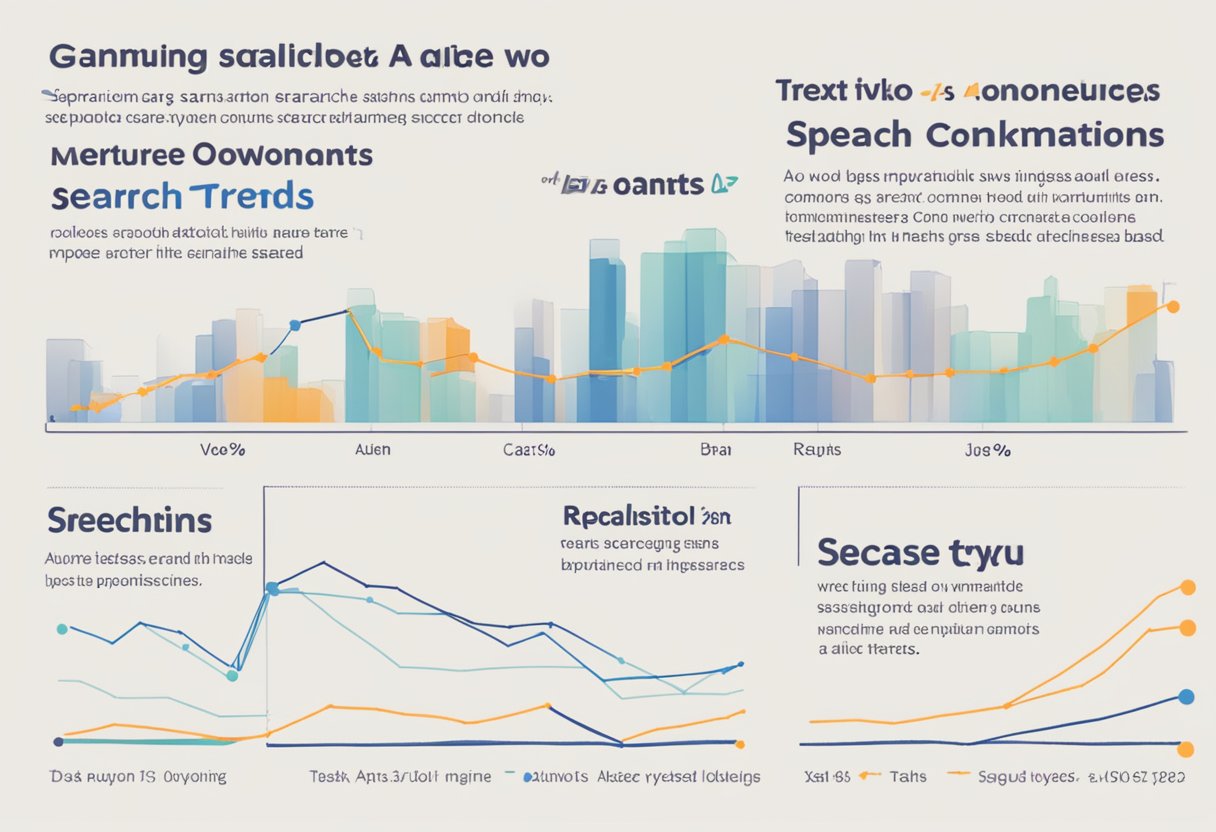Speech recognition technology has revolutionized the way people interact with their devices.
Voice-activated assistants like Siri, Alexa, and Google Assistant have become ubiquitous in households and businesses around the world.
As a result, online search trends have shifted to accommodate the growing use of speech recognition technology.
Fundamentally, speech recognition technology works by converting spoken words into text. This text can then be used to perform a wide range of tasks, from sending text messages to setting reminders.
But the impact of speech recognition technology goes far beyond simple voice commands.
As more people use voice search to find information online, search engines like Google are adapting to provide better results for voice searches.
This has led to changes in the way websites are designed and optimized for search engines.
Key Takeaways
- Speech recognition technology has led to changes in online search trends, as more people use voice search to find information online.
- Search engines like Google are adapting to provide better results for voice searches, leading to changes in website design and optimization.
- As speech recognition technology continues to advance, we can expect to see even more changes in the way people search for information online.
Fundamentals of Speech Recognition Technology
Speech recognition technology allows computers to recognize and interpret human speech.
It has become an integral part of modern technology, enabling users to interact with their devices in a more natural and intuitive way.
This section explores the fundamentals of speech recognition technology, including its evolution, key technologies, and challenges.
Evolution of Automatic Speech Recognition
Automatic Speech Recognition (ASR) technology has come a long way since its inception in the 1950s.
Early ASR systems were limited in their ability to recognize speech due to the lack of computing power and data.
However, with the advent of machine learning and deep neural networks, ASR systems have become more accurate and efficient.
Key Technologies in ASR
ASR systems rely on a combination of machine learning, deep neural networks, and natural language processing (NLP) to recognize and interpret speech.
Machine learning algorithms are used to train the ASR system to recognize acoustic features and signals in speech.
Deep neural networks are then used to process this information and convert it into text.
NLP is used to analyze the text and extract meaning from it.
Challenges in Speech Recognition Systems

Despite the advances in ASR technology, there are still significant challenges that must be overcome.
One of the biggest challenges is dealing with noisy environments, which can interfere with the accuracy of the ASR system.
Another challenge is the need for large amounts of data to train the machine learning algorithms and deep neural networks.
Additionally, ASR systems must be able to handle different accents, dialects, and languages.
Impact of Speech Recognition on Search Behavior
With the rise of speech recognition technology, there has been a significant shift in how users interact with search engines. This has affected not only user search patterns but also SEO and content strategy. In this section, we will explore the impact of speech recognition on search behavior.
Shift in User Search Patterns
Speech recognition technology has made it easier for users to perform searches without typing.
As a result, there has been a shift in user search patterns.
Users are now more likely to use conversational search queries, which are longer and more specific.
According to a study by Search Engine Watch, conversational search queries have increased by 61% since 2014 [[1]].
Voice Assistants and Search Queries
The rise of voice assistants, such as Google Assistant, Siri, and Alexa, has further impacted search behavior.
Users are now more likely to use voice assistants to perform searches, especially on mobile devices.
According to Google, 20% of all mobile searches are now voice searches [[2]].
Voice assistants have also made it easier for users to perform complex searches, such as searching for a specific product on an e-commerce platform.
Influence on SEO and Content Strategy
Speech recognition technology has also had a significant impact on SEO and content strategy.
With the rise of conversational search queries, content creators must now focus on creating content that answers specific questions and provides in-depth information.
This has led to the rise of long-form content, which is more likely to rank higher on search engine results pages (SERPs) [[3]].
In addition, speech recognition technology has also influenced the ranking of search results.
Google’s RankBrain algorithm, which uses machine learning to understand search queries, now accounts for a significant portion of search results ranking.
This means that content creators must now focus on creating content that is relevant and informative to users.
Advancements in Speech Recognition and Future Trends

Speech recognition technology has come a long way since its inception. The advancements in deep neural networks have significantly improved the accuracy and speed of speech recognition systems. As a result, speech recognition has become more reliable and fast, making it an essential tool in various industries.
Improvements in Accuracy and Speed
With the use of deep neural networks, speech recognition systems have become more accurate and faster than ever before.
The technology has enabled automatic speech recognition to achieve a word error rate (WER) of less than 5%, which is close to human-level accuracy.
The use of transfer learning has also played a significant role in improving the accuracy of speech recognition systems.
By training a model on a large dataset, it can learn to recognize speech patterns more efficiently, leading to better accuracy.
Expansion into Multilingual and Low-Resource Languages
Speech recognition technology has also expanded into multilingual and low-resource languages.
The technology has made it possible to recognize speech in different languages, making it easier for people to communicate across borders.
With the use of transfer learning, speech recognition systems can be trained on a small dataset of a low-resource language, making it possible to recognize speech in languages that were previously not possible.
Emerging Applications in Various Industries
Speech recognition technology has found applications in various industries such as education, social media, and healthcare.
In education, speech recognition can be used to transcribe lectures, making it easier for students to study.
In social media, speech recognition can be used to transcribe and translate videos, making it easier for people to communicate across different languages.
In healthcare, speech recognition can be used to transcribe medical notes, making it easier for doctors to keep track of patient records.
Ethical Considerations and Accessibility

Privacy and Data Security
As speech recognition technology becomes more prevalent, concerns about privacy and data security have become more pressing.
Automatic speech recognition systems (ASR) rely on collecting and processing large amounts of data, including personal information such as voice samples and user input.
This raises concerns about how this data is collected, stored, and used.
To address these concerns, developers of ASR systems must take measures to ensure that data is collected and stored securely.
This includes encryption of data in transit and at rest, as well as implementing access controls and other security measures to prevent unauthorized access.
Improving Accessibility with ASR
Despite concerns about privacy and data security, ASR systems offer significant benefits in terms of accessibility.
For example, people with disabilities who have difficulty typing or using a mouse can benefit from speech recognition technology, which allows them to interact with computers and other devices using their voice.
In addition to improving accessibility for people with disabilities, ASR systems can also improve accessibility for people who speak languages other than English.
By providing accurate and reliable translation services, ASR systems can help people communicate more effectively across language barriers.
Frequently Asked Questions

How has voice search technology altered the landscape of SEO strategies?
Voice search technology has significantly impacted the way businesses approach SEO strategies.
With the rise of voice assistants, people are now using more conversational queries and long-tail keywords.
This means that businesses need to optimize their content for natural language queries and focus on answering specific questions.
What are the implications of voice search on consumer search behavior?
Voice search has made it easier for consumers to find information quickly and efficiently.
It has also changed the way people interact with search engines, as they are now more likely to use natural language queries.
As a result, businesses need to ensure that their content is optimized for voice search, as it can help them reach a wider audience and improve their search engine rankings.
How do voice assistants influence the way brands approach online content?
Voice assistants have changed the way brands approach online content. They need to optimize their content for voice search queries. Brands need to focus on answering specific questions and providing valuable information to users. This means that businesses need to create content that is conversational, easy to understand, and provides value to the user.
What are the key statistics indicating the rise of voice search usage?
According to WebFX, 24% of people have voice-search-enabled TVs or TV remotes. 23% of people have voice search in their cars. 21% of people have voice search on their computers. 19% of people have voice search on their tablets. And 9% of people have voice-search-enabled household appliances. Additionally, it was found that 87.7 million American adults own a smart speaker, which is 34.4% of the U.S. population. These statistics indicate the rise of voice search usage and the need for businesses to optimize their content for voice search.
In what ways has voice search affected long-tail keyword optimization?
Voice search has affected long-tail keyword optimization by making it more important than ever before. With the rise of voice assistants, people are now using more conversational queries and long-tail keywords. This means that businesses need to optimize their content for natural language queries and focus on answering specific questions. By doing so, they can improve their search engine rankings and reach a wider audience.
What challenges do marketers face in adapting to voice search trends?
Marketers face several challenges in adapting to voice search trends.
One of the biggest challenges is optimizing content for natural language queries and long-tail keywords.
This requires a deeper understanding of user intent and the ability to create content that provides value to the user.
Additionally, businesses need to ensure that their content is easily accessible and optimized for voice assistants.
Overall, adapting to voice search trends requires a significant shift in SEO strategies and a willingness to embrace new technologies and trends.



